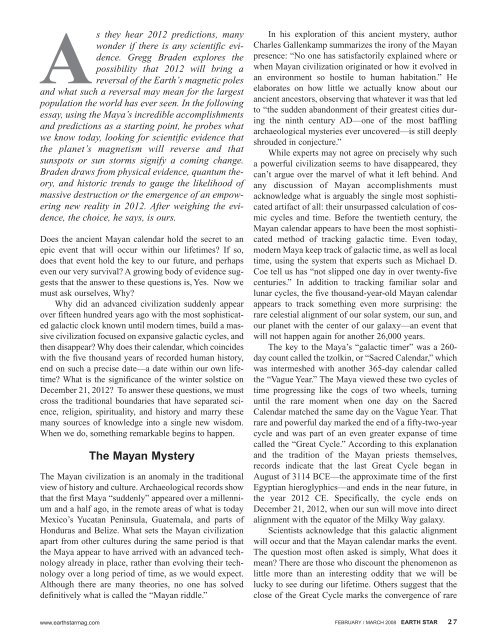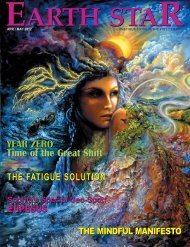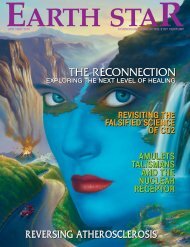GREGG BRADEN GREGG BRADEN - Earthstar
GREGG BRADEN GREGG BRADEN - Earthstar
GREGG BRADEN GREGG BRADEN - Earthstar
- No tags were found...
Create successful ePaper yourself
Turn your PDF publications into a flip-book with our unique Google optimized e-Paper software.
As they hear 2012 predictions, manywonder if there is any scientific evidence.Gregg Braden explores thepossibility that 2012 will bring areversal of the Earth’s magnetic polesand what such a reversal may mean for the largestpopulation the world has ever seen. In the followingessay, using the Maya’s incredible accomplishmentsand predictions as a starting point, he probes whatwe know today, looking for scientific evidence thatthe planet’s magnetism will reverse and thatsunspots or sun storms signify a coming change.Braden draws from physical evidence, quantum theory,and historic trends to gauge the likelihood ofmassive destruction or the emergence of an empoweringnew reality in 2012. After weighing the evidence,the choice, he says, is ours.Does the ancient Mayan calendar hold the secret to anepic event that will occur within our lifetimes? If so,does that event hold the key to our future, and perhapseven our very survival? A growing body of evidence suggeststhat the answer to these questions is, Yes. Now wemust ask ourselves, Why?Why did an advanced civilization suddenly appearover fifteen hundred years ago with the most sophisticatedgalactic clock known until modern times, build a massivecivilization focused on expansive galactic cycles, andthen disappear? Why does their calendar, which coincideswith the five thousand years of recorded human history,end on such a precise date—a date within our own lifetime?What is the significance of the winter solstice onDecember 21, 2012? To answer these questions, we mustcross the traditional boundaries that have separated science,religion, spirituality, and history and marry thesemany sources of knowledge into a single new wisdom.When we do, something remarkable begins to happen.The Mayan MysteryThe Mayan civilization is an anomaly in the traditionalview of history and culture. Archaeological records showthat the first Maya “suddenly” appeared over a millenniumand a half ago, in the remote areas of what is todayMexico’s Yucatan Peninsula, Guatemala, and parts ofHonduras and Belize. What sets the Mayan civilizationapart from other cultures during the same period is thatthe Maya appear to have arrived with an advanced technologyalready in place, rather than evolving their technologyover a long period of time, as we would expect.Although there are many theories, no one has solveddefinitively what is called the “Mayan riddle.”In his exploration of this ancient mystery, authorCharles Gallenkamp summarizes the irony of the Mayanpresence: “No one has satisfactorily explained where orwhen Mayan civilization originated or how it evolved inan environment so hostile to human habitation.” Heelaborates on how little we actually know about ourancient ancestors, observing that whatever it was that ledto “the sudden abandonment of their greatest cities duringthe ninth century AD—one of the most bafflingarchaeological mysteries ever uncovered—is still deeplyshrouded in conjecture.”While experts may not agree on precisely why sucha powerful civilization seems to have disappeared, theycan’t argue over the marvel of what it left behind. Andany discussion of Mayan accomplishments mustacknowledge what is arguably the single most sophisticatedartifact of all: their unsurpassed calculation of cosmiccycles and time. Before the twentieth century, theMayan calendar appears to have been the most sophisticatedmethod of tracking galactic time. Even today,modern Maya keep track of galactic time, as well as localtime, using the system that experts such as Michael D.Coe tell us has “not slipped one day in over twenty-fivecenturies.” In addition to tracking familiar solar andlunar cycles, the five thousand-year-old Mayan calendarappears to track something even more surprising: therare celestial alignment of our solar system, our sun, andour planet with the center of our galaxy—an event thatwill not happen again for another 26,000 years.The key to the Maya’s “galactic timer” was a 260-day count called the tzolkin, or “Sacred Calendar,” whichwas intermeshed with another 365-day calendar calledthe “Vague Year.” The Maya viewed these two cycles oftime progressing like the cogs of two wheels, turninguntil the rare moment when one day on the SacredCalendar matched the same day on the Vague Year. Thatrare and powerful day marked the end of a fifty-two-yearcycle and was part of an even greater expanse of timecalled the “Great Cycle.” According to this explanationand the tradition of the Mayan priests themselves,records indicate that the last Great Cycle began inAugust of 3114 BCE—the approximate time of the firstEgyptian hieroglyphics—and ends in the near future, inthe year 2012 CE. Specifically, the cycle ends onDecember 21, 2012, when our sun will move into directalignment with the equator of the Milky Way galaxy.Scientists acknowledge that this galactic alignmentwill occur and that the Mayan calendar marks the event.The question most often asked is simply, What does itmean? There are those who discount the phenomenon aslittle more than an interesting oddity that we will belucky to see during our lifetime. Others suggest that theclose of the Great Cycle marks the convergence of rarewww.earthstarmag.comFEBRUARY / MARCH 2008 EARTH STAR 27
















